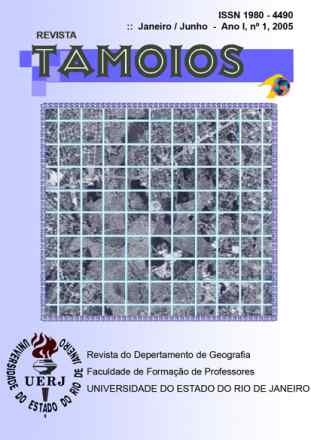CARACTERÍSTICAS ATUAIS DO CIRCUITO INFERIOR DA ECONOMIA URBANA DO EIXO RODOVIÁRIO NATAL-CAICÓ, RIO GRANDE DO NORTE
Revista Tamoios
CARACTERÍSTICAS ATUAIS DO CIRCUITO INFERIOR DA ECONOMIA URBANA DO EIXO RODOVIÁRIO NATAL-CAICÓ, RIO GRANDE DO NORTE
Autor Correspondente: D.S.C. de Oliveira Salvador | [email protected]
Palavras-chave: Circuito inferior da economia urbana; especificidades territoriais; difusão de variáveischave da Globalização; resistências à essa difusão; eixo rodoviário Natal-Caicó.
Resumos Cadastrados
Resumo Português:
Além de compreender as relações entre os circuitos da economia urbana, é importante apreender as características absolutas de cada subsistema socioeconômico na atualidade, tendo-se em vista os diferentes usos das variáveis-chave do período atual (técnica, ciência, informação, finanças, consumo) e, assim, as diferentes intencionalidades agindo na dinâmica territorial. Com esse entendimento, objetivamos apreender as características atuais do circuito inferior da economia urbana considerando a incorporação de variáveis-força do circuito superior e a resistência a elas por atividades não hegemônicas. Para isso, adotamos como recorte de análise o eixo rodoviário Natal-Caicó, devido ao fato desse subsistema de movimentos do território potiguar interligar municípios do interior e do litoral do estado, se destacar pelos fluxos intermunicipais de passageiros e se caracterizar por cidades cujo centro econômico importante é a rodovia que as atravessa, sendo a rodovia margeada, sobretudo, por diversas atividades da economia não hegemônica. Assim, consideramos que, nas cidades em que a gama de atividades do circuito superior é menor, as possiblidades de difusão das variáveis-chave da Globalização no circuito inferior também são menores, devido ao fato de os circuitos coexistirem. Além disso, no circuito inferior são evidenciadas algumas resistências à incorporação cabal das premissas do circuito superior na organização de atividades não hegemônicas, por meio de ações que realçam que o peso da densidade comunicacional no circuito inferior pode ser maior, inclusive, que o das densidades técnicas, informacionais e normativas, e que evidenciam situações em que agentes não hegemônicos, mais do que concorrentes, podem ser parceiros na busca pela sobrevivência.
Resumo Inglês:
In addition to understanding the relationship between urban economy circuits, it is important to grasp the absolute characteristics of each socioeconomic subsystem, having in mind the different uses of the key variables of the current period (technical, science, information, finance, consumption) and thus the different intentions in territorial dynamics. With this understanding, we aimed to understand the current features of the lower circuit of the urban economy considering the incorporation of variablesstrength of upper circuit and resistance to them by hegemonic activities. We have adopted as analysis clipping the road axis Natal-Caicó, due to the fact that the moves subsystem of territory connects municipalities of the interior and the coast of the State, stand out by intercity passenger flows and be characterized by cities whose economic center is the highway that passes through, being the highway bordered by various activities of the economy not hegemonic. So, we think that in the cities in which the range of activities of the upper circuit is smaller, the possibilities of dissemination of key variables of globalization in lower circuit are also smaller, due to the fact the circuits coexist. In addition, at the lower circuit are shown some resistance to the full incorporation of the premises of the upper circuit in organization of not hegemonic activities, through actions that enhance the weight of communicational density in the lower circuit can be greater, including that the technical and informational densities, and which highlight situations in which hegemonic not agents, more than competitors, can be partners in the quest for survival.

